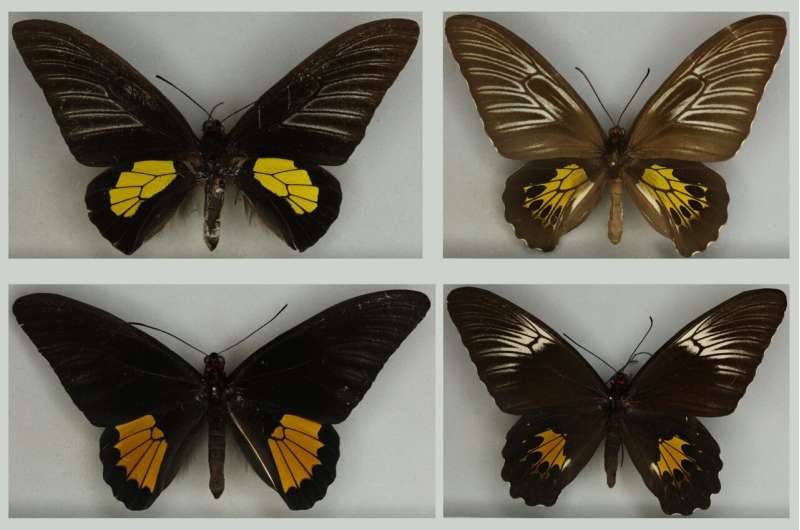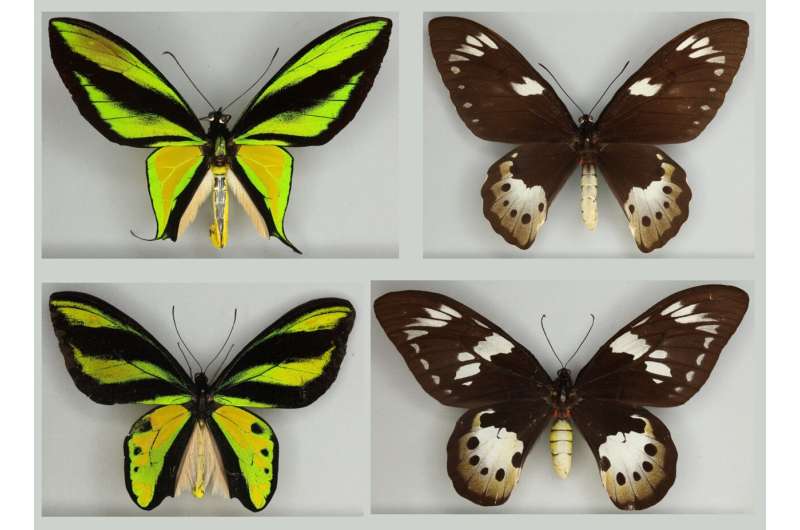
Bird butterflies of the Troides halipron species group, in which females (right) were observed to be more diverse than males (left). Credit: Natural History Museum. 2024. Bird-winged butterflies (from collection specimens). Licensed under CC-BY-4.0.
Pioneering AI research on butterflies has probed the understudied evolution of females and adds to a debate between the founding fathers of evolution.
University of Essex study – published in Biology of communications-explores a controversy between Victorian scientists Charles Darwin and Alfred Russel Wallace.
Darwin thought that males had more variation, as females often chose mates based on male appearance. While Wallace thought that natural selection between the sexes was the biggest factor in change.
For more than a century, scientists have mainly studied males because their differences are more obvious, while females, with more subtle evolutionary changes, were less studied.
Using high-tech machine learning, Dr. Jennifer Hoyal Cuthill examined more than 16,000 male and female birdwing butterflies, with collaborators from the Natural History Museum and AI Cross Labs research institute, Cross Compass. This is the first time visual differences between the sexes have been explored across the species, which live in Southeast Asia and Australasia.
Birdwing butterflies were chosen for this study because of their spectacular wing color patterns and differences between males and females.
Dr. Cuthill, from the School of Life Sciences, said: “This is an exciting time, when machine learning is enabling new, large-scale tests of old questions in evolutionary science.
“For the first time we are able to measure the apparent extents of evolution to test how much variation is present in different biological groups and between males and females. Machine learning is giving us new information about the evolutionary processes that generate and preserve biodiversity, including historically neglected groups”.

Bird-winged butterflies of the Ornithoptera paradisea species group, in which males (left) were observed to be more diverse than females (right). Credit: Natural History Museum. 2024. Bird-winged butterflies (from collection specimens). Licensed under CC-BY-4.0.
The study looked at photographs of butterflies from Natural History Museum collections, which show a range of traits, such as shapes, colors and wing patterns, in several species. He found that while males often have more distinct shapes and patterns, both males and females contribute to the overall diversity.
The research showed that the evolutionary patterns predicted by Darwin and Wallace were found in butterflies, showing that both males and females contribute to diversity among species. Males showed more variation in appearance, which fits with Darwin’s idea that females choose mates based on these traits.
However, deep learning also found subtle differences in females, matching Wallace’s predictions about natural selection allowing for diversity in female phenotypes.
Dr. Cuthill said, “Birdwings have been described as among the most beautiful butterflies in the world. This study gives us new insights into the evolution of their extraordinary but endangered diversity.
“In this case study of birdwing butterfly photographs, it is sex that appears to have driven the greatest evolutionary change, including extreme male shapes, colors and patterns. However, within the group of birdwing butterflies, we we found contrasting examples where female birdwing butterflies are more diverse in apparent phenotype than males and vice versa.
“The high apparent diversity among male butterflies supports the real-world importance of sexual selection by female mate choice on the male variant, as first suggested by Darwin. Cases where female butterflies are more diverse than males of their species support an additional important role for naturally selected female variation in interspecies diversity, as suggested by Wallace.
“Large-scale studies of evolution using machine learning offer new opportunities to resolve debates that have been outstanding since the foundation of evolutionary science.”
More information:
Male and female contributions to diversity among bird wing butterfly images, Biology of communications (2024). DOI: 10.1038/s42003-024-06376-2
Provided by the University of Essex
citation: Research shows Darwin and Wallace both right on butterfly evolution (2024, July 1) retrieved July 1, 2024 from https://phys.org/news/2024-06-darwin-wallace-butterfly-evolution. html
This document is subject to copyright. Except for any fair agreement for study or private research purposes, no part may be reproduced without written permission. The content is provided for informational purposes only.